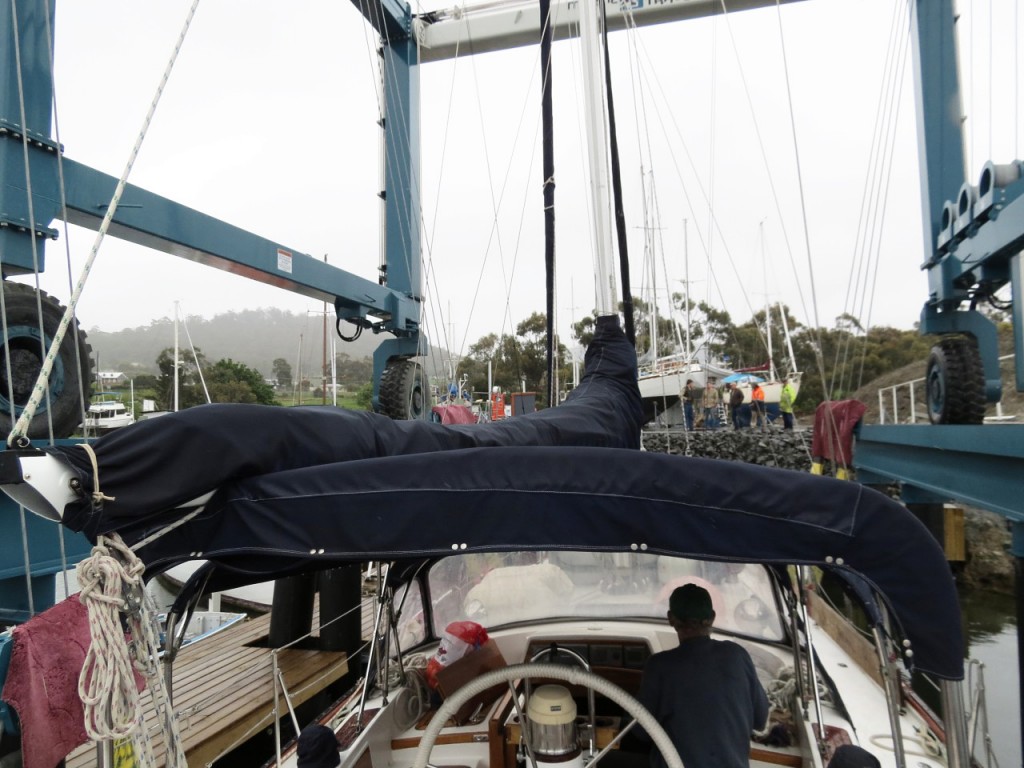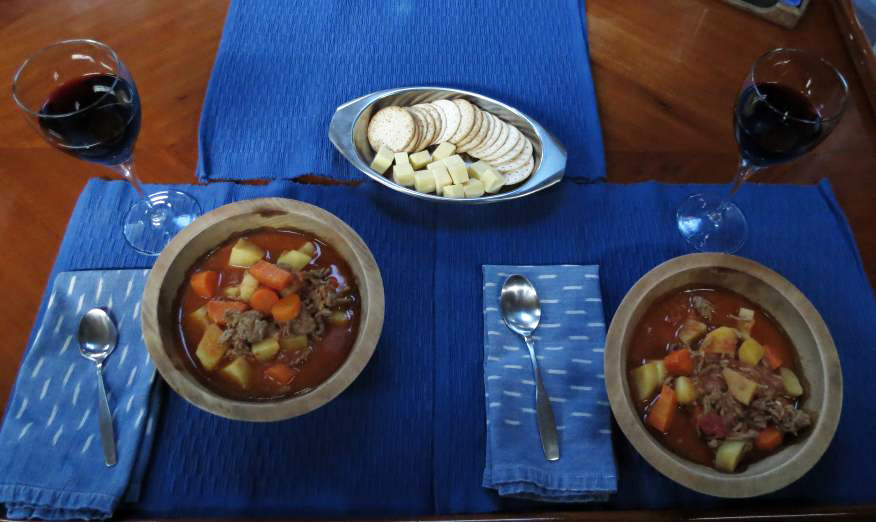Haul-Out Day
/ Boats aren't meant to be out of the water. That's probably the reason why hauling the boat once every year or so is always met with a bit of trepidation. Like anything else, once you've done it a few times, you at least know what to expect, but still we're hauling a 21 ton boat out of the water supported only by two huge heavy-duty slings. Each marina does things a little differently. Everything usually goes just fine; we've never had a problem. Sometimes things do go wrong, however, and we've seen the results. Not pretty. Fingers are always crossed.
Boats aren't meant to be out of the water. That's probably the reason why hauling the boat once every year or so is always met with a bit of trepidation. Like anything else, once you've done it a few times, you at least know what to expect, but still we're hauling a 21 ton boat out of the water supported only by two huge heavy-duty slings. Each marina does things a little differently. Everything usually goes just fine; we've never had a problem. Sometimes things do go wrong, however, and we've seen the results. Not pretty. Fingers are always crossed.
 The main reason for hauling a boat is to handle under waterline repairs, repaint the bottom with anti-fouling and generally inspect all the parts that usually sit under water. We have our standard list of what needs to be done plus new chores always pop up. We've given ourselves a pretty tight schedule for getting everything accomplished. Being “on the hard” here in Australia is an expensive proposition.
The main reason for hauling a boat is to handle under waterline repairs, repaint the bottom with anti-fouling and generally inspect all the parts that usually sit under water. We have our standard list of what needs to be done plus new chores always pop up. We've given ourselves a pretty tight schedule for getting everything accomplished. Being “on the hard” here in Australia is an expensive proposition.
 We “kissed a bommie” (read that nudged up against a coral head) in Fiji last season. It wasn't extensive or serious, but the keel will need some repair. David wants to repaint the bootstripe. My job is usually painting the bottom while David is doing the other chores on the list. The boat bottom is never so big as when I'm painting it...three times. Antifouling paint ostensibly keeps things from growing on the bottom of the boat, like barnacles, worms, reef plants, etc. In order to be effective it has a high anti-sea critter growth content and is pretty toxic to humans. I wear my Pillsbury Doughgirl disposable Tyvec coveralls and a respirator. Fashion doesn't count here, thank goodness, plus no one would ever recognize me.
We “kissed a bommie” (read that nudged up against a coral head) in Fiji last season. It wasn't extensive or serious, but the keel will need some repair. David wants to repaint the bootstripe. My job is usually painting the bottom while David is doing the other chores on the list. The boat bottom is never so big as when I'm painting it...three times. Antifouling paint ostensibly keeps things from growing on the bottom of the boat, like barnacles, worms, reef plants, etc. In order to be effective it has a high anti-sea critter growth content and is pretty toxic to humans. I wear my Pillsbury Doughgirl disposable Tyvec coveralls and a respirator. Fashion doesn't count here, thank goodness, plus no one would ever recognize me.
 The weather has been seasonably pleasant and sunny the last few days. And then today, when we wanted to haul out, it turned stinky. The wind howled through the night and it rained buckets. It seemed to lighten up a bit around 0800, but a quick trip to the toilet block and we were soaked. I looked at the weather and thought “Nah”. David looked at the weather and said “No worries...ready to go?” There's definitely a major difference in our wiring.
The weather has been seasonably pleasant and sunny the last few days. And then today, when we wanted to haul out, it turned stinky. The wind howled through the night and it rained buckets. It seemed to lighten up a bit around 0800, but a quick trip to the toilet block and we were soaked. I looked at the weather and thought “Nah”. David looked at the weather and said “No worries...ready to go?” There's definitely a major difference in our wiring.
We backed out of the berth around 0930. David finally got the hydraulic fittings he needed and was able to replace the hoses, so we even had steerage as we headed into the TravelLift bay. The rain alternated between drizzle and downpour and the temperature dropped. We were wet, cold and shivering.
 The haul-out was a long process. David thought the forestay would need moving. He usually has to do this, depending on the size of the lift hauling us out. But the TravelLift operator thought not. That's a bonus. But then of course, after getting the boat in the slings and hauling her up, it was determined that yes, he would have to detach the forestay in order to raise her high enough to lift her onto land. Another 30 minute delay as he coaxed cotter pins out of place, snipped seizing wire, loosened backstays and finally bound the forestay to the port lifelines to give us enough clearance in the lift. Back up in the lift and still not quite enough clearance. This time, they readjusted the slings and up she came.
The haul-out was a long process. David thought the forestay would need moving. He usually has to do this, depending on the size of the lift hauling us out. But the TravelLift operator thought not. That's a bonus. But then of course, after getting the boat in the slings and hauling her up, it was determined that yes, he would have to detach the forestay in order to raise her high enough to lift her onto land. Another 30 minute delay as he coaxed cotter pins out of place, snipped seizing wire, loosened backstays and finally bound the forestay to the port lifelines to give us enough clearance in the lift. Back up in the lift and still not quite enough clearance. This time, they readjusted the slings and up she came.
 Remarkably, after sitting for several months, unmoved in her berth here, her bottom was quite clean. Slime prevailed, but very few barnacles or other growth. We had expected a mini-reef, but were pleasantly surprised. David used the marina's power washer and got most of the slime off. What looked like a black-bottomed boat was indeed still blue without the slime overcoat. What few barnacles there were, we attacked with a putty knife and they popped right off.
Remarkably, after sitting for several months, unmoved in her berth here, her bottom was quite clean. Slime prevailed, but very few barnacles or other growth. We had expected a mini-reef, but were pleasantly surprised. David used the marina's power washer and got most of the slime off. What looked like a black-bottomed boat was indeed still blue without the slime overcoat. What few barnacles there were, we attacked with a putty knife and they popped right off.
 Next, wet sanding. Preparation here is important as with most painting jobs. We wet sanded the bottom, roughing it up and removing any other surface debris to insure good anti-fouling adherence. We probably won't haul her again for another 18 months to two years, this has got to be a good job to last us. We were both blue with old bottom paint by the time we were finished, but a good job done. David finished out the day by masking the bootstripe. Painting will begin tomorrow. We're hoping it will warm up so the epoxy work can begin. It's a small area to be repaired and I'll paint around it while David is working or just paint right over David. Depends on my mood!
Next, wet sanding. Preparation here is important as with most painting jobs. We wet sanded the bottom, roughing it up and removing any other surface debris to insure good anti-fouling adherence. We probably won't haul her again for another 18 months to two years, this has got to be a good job to last us. We were both blue with old bottom paint by the time we were finished, but a good job done. David finished out the day by masking the bootstripe. Painting will begin tomorrow. We're hoping it will warm up so the epoxy work can begin. It's a small area to be repaired and I'll paint around it while David is working or just paint right over David. Depends on my mood!





